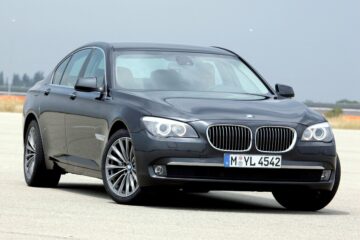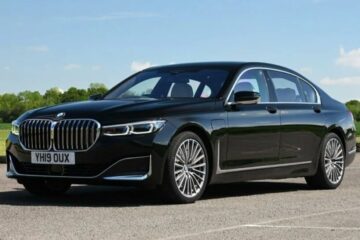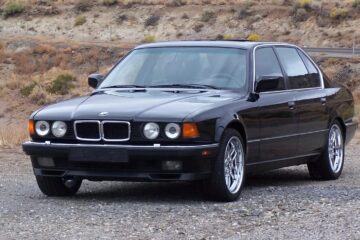The history of the BMW 7 Series E65 and E66, which is the fourth generation of the luxury sedan, began in 1997. At that time, the development of the design together with a large American company began. At the Frankfurt Motor Show in 2001, this model was first presented to the public, sales started a few months after the premiere. In March, BMW 7 Series E65 2002 at the Geneva Motor Show was presented a lengthened version of the sedan long, which received the index E66.
The year 2005 was marked by a restyling of the flagship model from the Bavarians. After that, it stayed in assembly for another three years. The total circulation of the fourth generation of the legend amounted to about 330 thousand copies.
Compared to its predecessors, the luxury sedan BMW 7 series E65 received a radically changed appearance, which caused a storm of criticism from fans of the brand. But despite this, designers managed to achieve stylish and relief forms of the fourth generation, which added a certain sportiness to the car. The aggressive look of the head optics, as well as the famous nostrils on the radiator grille remained unchanged, despite the radical design update.
Exterior
According to the owners’ reviews, the body on the BMW E65 is characterized by a rather calm appearance, which is diluted with small notes of aggression. To say that the design is old does not turn the tongue, as even by modern standards the appearance is relatively good. The front part is distinguished by a long hood, which has relief massive lines on the edges. On the front end, large xenon headlights equipped with BMW Dynamic Xenon optics immediately catch the eye. Without the traditional “angel eyes” also did not do without, so the headlights of BMW E65 do not stand out from the general style of the company.
The large nostrils adorning the signature 2001 BMW E65 radiator grille are made entirely of chrome. The front bumper is also characterized by rather large dimensions and the presence of a chrome insert. The lower part of the bumper is decorated with an air intake and fog lights.
The E65 looks as stunning from the side as it does from the front. The wheel arches are adorned with small extensions that have a bevel line. The upper and lower part stands out from the rest of the car by having shallow stamped lines at the bottom and top. The rest of the details are made without any notable features, so they do not catch the eye.
The rear part is distinguished by branded optics, part of which is located on the luggage compartment lid. The lid itself is made with relief shapes. The rear bumper is quite large, equipped with moldings and a large reflector in the lower part. This part is painted by the factory in body color.
With all the attractive features, the car also stands out with impressive dimensions: the body length is 5039 millimeters and width is 1902 millimeters, while it is 1491 millimeters in height. On the wheelbase from the length is allocated more than half – 2990 millimeters. The ground clearance is 151 millimeters. Traditionally, there is also a place in the model range for the Long modification, the body of which is longer by 140 millimeters and slightly lower.
Interior
There are no complaints about the interior space, even if we evaluate it by modern standards. The quality of assembly, as well as the materials used for upholstery of the BMW E65 interior, are at a very high level. The front seats are electrically adjustable and fully covered with leather. Buttons responsible for adjustment are located in a convenient and accessible place – on the sides of the armrest. As a pleasant surprise for the front passenger and driver can be highlighted heating and ventilation.
To the rear row of seats the manufacturers paid special attention. It is also characterized by the use of leather upholstery. Regardless of whether your version is extended or regular, the rear row can accommodate three passengers. The space between the front seats houses a small-sized multimedia display. Two cigarette lighters are offered for the convenience of passengers. The wide armrest is tiltable and equipped with buttons for electric seat adjustment, a drawer for small things. In the rear part there is a refrigerator. It is also possible to allocate and retractable cup holders.
Immediately finding himself in the cabin, the driver pays attention to the steering wheel with leather trim, made in the form with three spokes. On the steering wheel there are 8 buttons for controlling the multimedia system. The steering column is electrically adjustable. On the dashboard there are two large gauges of tachometer and speedometer. The driver can get the rest of the information from the on-board computer monitor.
On the center console you can also find a lot of interesting chips. The upper part of the torpedo panel is characterized by a small monitor of navigation and multimedia system, there is no touch control in the screen. In the lower part there are controls for separate climate control, the key is inserted on the left. At the very bottom you can find an ashtray and niches for various trifles. In the tunnel there is an additional drawer for small things, as well as two cup holders, which can cool or heat drinks. At the end there is a massive armrest, on which there is a puck for controlling the multimedia system and buttons for adjusting the position of the seats. The gearbox selector has moved to the steering wheel, similar to American cars.
The usable trunk space of the BMW E65 has not received any changes in comparison with the previous generation. Its volume is 500 liters, which is quite enough for a car of this class.
Engines
In the lineup of BMW E65 2003, as well as in previous generations of German flagships, there is a large range of power units. Almost all motors are gasoline, but there are also diesel variants. To begin with, let’s consider the gasoline engines.
As a base engine was chosen internal combustion engine N52, which is capable of producing up to 258 horsepower with a working volume of 3 liters. This is a six-cylinder inline engine, with which the BMW E65 consumption reaches 14 liters of 98-grade gasoline per hundred kilometers of travel while driving in the city. It is characterized by multi-point injection.
The next powertrain in the lineup features eight cylinders lined up in a V layout, giving it a 4.0-liter displacement. It is slightly larger, producing up to 306 horsepower. This has resulted in an increase in fuel consumption by two liters with the same injection system. The lineup also includes an atmospheric V8 powertrain with 4.8 liters of displacement with the N62 index. It is capable of delivering up to 367 horsepower with a maximum torque of 490 Nm. Consumption is slightly higher, but it provides good dynamics.
The last in the lineup is the N73 gasoline motor, which is the most popular among fans of the German car industry. The layout is the same – V, but there are more cylinders – 12 pieces. This gives a working volume of 6 liters and a power of up to 445 horsepower with a maximum torque of 600 Nm. The minimum fuel consumption with direct injection is about 20 liters when driving in the city. There were only three diesel power units, and the extended version was offered with only one variant. The first motor was a turbocharged internal combustion engine with an in-line arrangement of six cylinders, distinguished by three liters of working volume. Its peak power is 231 horsepower. Thanks to direct fuel injection it is possible to achieve maximum economy – in the city fuel consumption is only 11 liters of diesel.
The second motor in the lineup was an eight-cylinder unit with V layout, which provided 4.4 liters of working volume. The maximum power of the motor is 300 horsepower with 700 Nm of peak torque. Consumption per hundred kilometers is about 14 liters. The last power unit in its structure does not have any differences from the previous one. Its power was increased to 329 horsepower, along with torque, which became 750 Nm.
One of the most common motors installed on this version is N62B48 for 4.8 liters. In principle, it did not cause big problems to owners, but on the condition that only high-quality fresh oil is used. Lubricating fluids are to be replaced after every 8-10 thousand kilometers of mileage. Problems may arise only with the system of changing gas distribution phases. These malfunctions are indicated by errors on the on-board computer, so experienced mechanics quickly eliminate them.
The cylinder head and valve cover require constant inspection for oil leaks. This is a common problem with the N62B44 engines used in the 745i before modernization. After the restyling, such problems are uncommon. This engine is equipped with an additional oil cooler to keep the lubricant at a normal temperature. However, it is around this unit that oil leaks can occur.
The M54 series gasoline power unit with a displacement of 3 liters is quite good and reliable. It is distinguished by the installation of electronic throttle, aluminum cylinder block and cast iron liners. Both camshafts are equipped with adjustable camshaft timing. The only serious problem is the crankcase ventilation valve, which is constantly clogged. For prevention it is recommended to replace it after 2-3 oil changes. Motors of the N52 line collect much less positive feedback from owners, but in any case, it is not very difficult to buy a contract engine.
The 730d version was powered by a turbo diesel engine with three liters of displacement. The 730d version was equipped with a turbo diesel engine with three liters of displacement. The 740d and 745d versions had turbocharged diesel engines with eight cylinders. These powertrains require much more expensive and better maintenance. The timing chain drive is relatively reliable. On an unheated car you can notice a kind of noise, which is acceptable if it disappears after reaching the operating temperature. If extraneous sounds are also noticeable on a warmed motor, it is worth paying attention to the tensioner. The plastic flaps in the intake manifold may also fail and produce extraneous noise.
Modifications
Version BMW E65 730i and its extended modification 730Li provided for the installation of engines M54B30 and N52B30, which had virtually the same displacement, rounded to 3 liters, and the power of 231 and 258 horsepower, respectively. The maximum torque of both engines was 300 Nm. The 735i modification and the extended 735Li counterpart housed the 3.6-liter N62B36 engine under the hood. Its peak output was 272 horsepower with 360 Nm of maximum torque.
In versions 740i and 740 Li under the hood you could find a motor N62B40 for 4 liters of working volume. The maximum power of such a power unit is 306 horsepower, and torque does not exceed 390 Nm. BMW 745i E65 and 745Li were equipped with a 4.4 liter N62B44 motor. Its maximum power was 333 horsepower with a peak torque of 450 Nm.
The 750i and 750Li versions were powered by the 4.8-liter N62B48 engine. This power unit provided the following BMW E65 characteristics: up to 367 horses of power with a maximum torque of 490 Nm. The 760i and 760Li modifications were equipped with the legendary N73B60 6-liter engine. This is the most powerful motor in the range – it is capable of producing up to 445 horsepower at a maximum torque of 600 Nm. Diesel version of BMW 730d E65 and 730Ld (the only diesel extended modification) provided installation of BMW E65 M57TUD30 and M57TU2D30 engines, which had a working volume of 3 liters. Their peak power was 218 and 231 horsepower, and torque reached 500 and 520 Nm, respectively. The 740d version was equipped with a diesel engine M67D39 for 3.9 liters, which provided the following specifications: capable of developing up to 258 horsepower with a maximum torque of 600 Nm.
The most powerful generation in the lineup is the 745d with the M67D44 engine, which had 4.5 liters of displacement and provided up to 329 horsepower with a maximum torque of 750 Nm.
Features
The suspension of the BMW 7 Series E65 is no different from other Bavarian cars. The suspension is fully independent and has two arms at the front and four at the rear. The stabilizers are active and the stiffness of the shock absorbers is adjustable. All wheels are equipped with a ventilated disc brake system. The BMW E65’s automatic transmission was characterized by great reliability.
The seventh series E65 was also produced in two limited modifications, which were not so widely spread due to their peculiarities:
- BMW High Security 7-Series with the index E67 is an armored vehicle featuring the B7 High Security. The equipment of this version included an automatic complex aimed at extinguishing fires, an autonomous fresh air supply system, an oxygen reserve aimed at prolonged stay under water and many other options.
- The BMW Hydrogen 7, which has been labeled the E68, is a limited edition hydrogen hybrid that has been produced in a run of 100 units.
Difference between restyling and prerestyling
In April 2005, the world saw a restyling of the BMW E65. The legendary sedan received more refined and sporty features. A new 3-liter N52 motor was introduced for the 730i and its Long version. The 740s replaced the 735s, which were equipped with N62 engines. The BMW 750 E65 replaced the BMW 745 E65, and the 740d was replaced by an updated 745d model. Diesel powertrains began to use particulate filters. The suspension of the car was also completely revised. Depending on the model, an improved braking system, bi-xenon optics and two-stage stop signals were fitted as standard equipment.
The review should start with the fact that external changes have been made to both bumpers, the legendary radiator grille has been replaced as well. The front and rear optics have also been updated. Modernization touched the hood, new wheel rims began to be installed, and the color range received additional colors. The range of interior finishing materials has also been expanded, despite the fact that the pre-style has never been characterized by a lack of choice for buyers.
The 745d underwent a notable change in August 2005, when its maximum horsepower was increased by 30 horsepower. A Long version was also added to the diesel lineup, equipped with the M57TU2D30 turbocharged motor. This is the end of the differences from the pre-styling.
The year 2008 was the last year for the production of the model range of the seventh series of German BMW E65 cars. After that, they were replaced by the next generation – F01-F04.
Generations and configurations
Sedan 4th generation – restyling
04.2005 – 10.2008
| 730i AT | N52B30 | 3.0l | 258 hp |
| 730Li AT | N52B30 | 3.0L | 258 hp |
| 740i AT | N62B40 | 4.0L | 306 hp |
| 740Li AT | N62B40 | 4.0L | 306 hp |
| 750i AT | N62B48 | 4.8L | 367 hp |
| 750Li AT | N62B48 | 4.8L | 367 hp |
| 760i AT | N73B60 | 6.0l | 445 hp |
| 760Li AT | N73B60 | 6.0L | 445 hp |
Fourth Generation Sedan
09.2001 – 03.2005
| 730i AT | M54B30 | 3.0l | 231 hp |
| 730Li AT | M54B30 | 3.0L | 231 hp |
| 735i AT | N62B36 | 3.6L | 272 hp |
| 735Li AT | N62B36 | 3.6L | 272 hp |
| 745i AT | N62B44 | 4.4L | 333 hp |
| 745Li AT | N62B44 | 4.4L | 333 hp |
| 760i AT | N73B60 | 6.0l | 445 hp |
| 760Li AT | N73B60 | 6.0L | 445 hp |
Fourth generation sedan – restyled
04.2005 – 10.2008
| 730i AT | N52B30 | 3.0l | 258 hp |
| 730Li AT | N52B30 | 3.0L | 258 hp |
| 730d AT | M57D30TU2 | 3.0L | 231 hp |
| 730Ld AT | M57D30TU2 | 3.0L | 231 hp |
| 740i AT | N62B40 | 4.0L | 306 hp |
| 740Li AT | N62B40 | 4.0L | 306 hp |
| 745d AT | M67D44 | 4.4l | 329 hp |
| 750i AT | N62B48 | 4.8L | 367 hp |
| 750Li AT | N62B48 | 4.8L | 367 hp |
| 760i AT | N73B60 | 6.0l | 445 hp |
| 760Li AT | N73B60 | 6.0L | 445 hp |



0 Comments